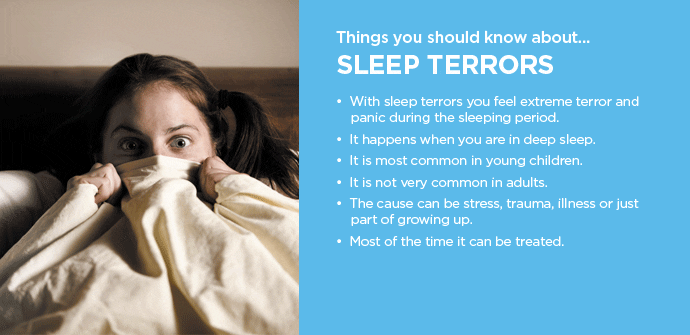Contents
What are night terrors?
Definition of night terrors
It is a sleep disorder in the child who stands up, starts to cry and sob in the middle of the night. It is therefore very worrying for parents. It is a parasomnia (para: beside, and somnia: sleep), motor or psychomotor behavior occurring during sleep, falling asleep or awakening,
And where the person is not or not fully aware of what they are doing.
Night terrors are frequent before the age of 6 and are linked to the maturation of sleep, the establishment of sleep phases and the installation of sleep / wake rhythms in children.
Symptoms of night terrors
Night terror manifests itself at the start of the night, during sleep, and during slow, deep sleep.
Suddenly (the start is brutal), the child
– Straightens,
– Open your eyes.
– He starts screaming, crying, sobbing, screaming (we’re talking about a Hitchcockian howl!)
– He seems to see terrifying things.
– He is not actually awake and we cannot wake him. If his parents try to console them, he does not seem to hear them, on the contrary it can increase his terror and trigger an escape reflex. He seems inconsolable.
– He’s sweaty,
– It’s red,
– His heartbeats are accelerated,
– His breathing is accelerated,
– He can speak incomprehensible words,
– He can struggle or adopt a defensive posture.
– It presents manifestations of fear, terror.
Then, after 1 to 20 minutes,
– The crisis ends quickly and suddenly.
– He does not remember anything the next day (amnesia).
Most children with night terrors have more than one episode, such as one episode every month for one to two years. Night terrors occurring every night are rare.
People at risk and risk factors for night terrors
– People at risk are children from 3 to 6 years old, an age at which nearly 40% of children present night terrors, with a slightly higher frequency for boys. They can begin at 18 months, and the frequency peak is between 3 and 6 years.
– There is a factor of genetic predisposition to night terrors. It corresponds to a genetic predisposition to partial awakenings in deep slow sleep. This explains why other parasomnia can coexist, such as sleepwalking, or somniloquia (talking during sleep).
Risk factors for night terrors:
Certain external factors can accentuate or provoke night terrors in predisposed children:
– Tiredness,
– Sleep deprivation,
– The irregularity of the hours of sleep,
– The noisy environment during sleep,
– Fever,
– Unusual physical exertion (late night sport)
– Certain drugs acting on the central nervous system.
– Sleep apnea.
Prevention of night terrors
Preventing night terrors is not necessarily possible since a genetic predisposition exists and it is most often a normal stage of sleep maturation.
– However, we can act on the risk factors in particular the lack of sleep. Here are the sleep needs of children according to their age:
– 0 to 3 months: 16 to 20 h / 24 h.
– 3 to 12 months: 13 to 14 hrs / 24 hrs
– 1 to 3 years old: 12 to 13 p.m. / 24h
– 4 to 7 years old: 10 to 11 hrs / 24 hrs
– 8 to 11 years old: 9 to 10 hrs / 24 hrs
– 12 to 15 years old: 8 to 10 hrs / 24h
In the event of limited sleep duration, it is possible to offer the child to take naps, which can have a beneficial impact.
– Limit the time in front of the screens.
TV screens, computers, tablets, video games, telephones are major sources of sleep deprivation in children. It therefore seems important to considerably limit their use and in particular to prohibit them in the evening to allow children to have sufficient and restful sleep.










